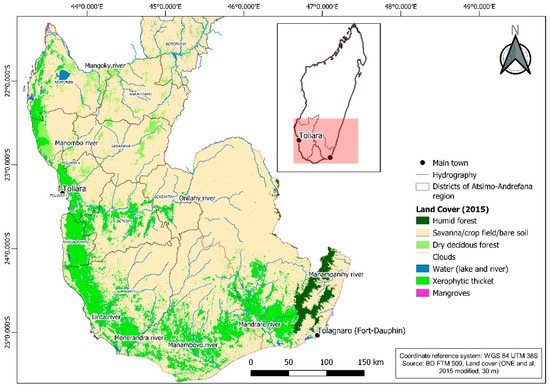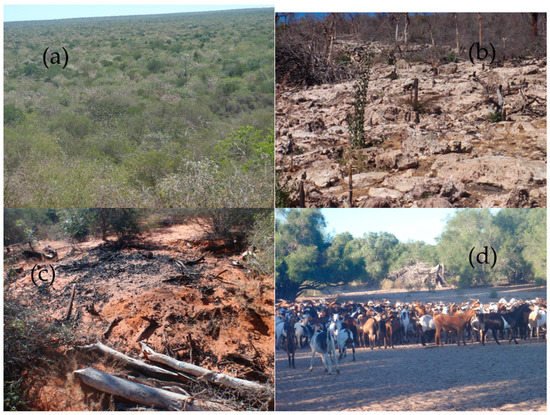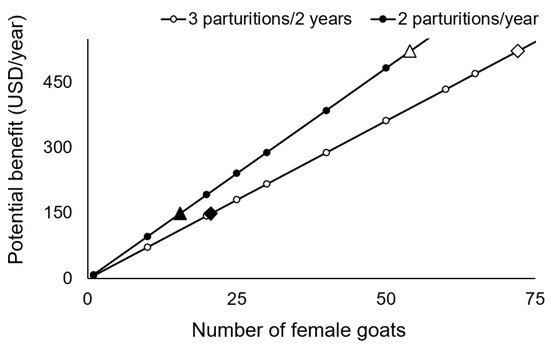Spiny thickets or xerophytic thickets (XTs) are a type of shrubby vegetation found in the far south and southwest of Madagascar, the driest parts of the island. This type of vegetation, which is rich in endemic animal and plant species, is endangered. Extensive local goat breeding (Capra hircus, for meat and milk production) based on XT browsing is an important source of household income. Improved goat breeding is an alternative to wood charcoal (WC) production and slash-and-burn agriculture (SBA), which are unsustainable activities.
- arid
- deforestation
- goat husbandry
- Madagascar
- rangeland
- sustainability
- slash-and-burn-agriculture
- wood charcoal
1. Introduction

2. Status of Malagasy XTs

- - Short shrubby XT (Figure 2a), dominated by Euphorbia spp. (mainly E. stenoclada and E. laro) not exceeding 4 m in height, represents the most xeric formation. The only Didiereaceae species occurring in this kind of XT are Alluaudia comosa and Alluaudia fiherenensis; and
- - Tall XT with Didierea madagascariensis, Adansonia fony, and Commiphora lamii associated with an average height of 4–6 m and emergent trees reaching 8–10 m.
3. Xerophytic Thickets as Wooded Goat Rangeland
4. Main Causes of XT Deforestation and Degradation
4.1. Slash-and-Burn Agriculture, the Main Cause of Deforestation in XTs
4.2. Wood Charcoal Production, a Major Source of XT Degradation
5. Goat Breeding: An Alternative to Wood Charcoal Production and Slash-and-Burn Agriculture in XTs
Goat breeding in southwestern Madagascar is extensive and suffers from low production rates due mainly to (i) long inter-gestation periods [59][60] and (ii) the high rate of mortality of kids reported by farmers [39][60][39,61]. Despite these limitations, goat breeding is an important source of income for farmers [17][55][17,43]. Indeed, goat sales constitute more than 50% of the annual household cash income in the commune of Soalara-Sud [55][43] and cover 15–29% of the net food expenditure on the entire Mahafaly Plateau (compared with less than 6% for food crops; [17]). However, the key question regarding improvements to goat breeding practices is: would this income incentive be sufficient to persuade the farmer to breed goats rather than to cultivate the land or to produce WC? Improved husbandry practices can indeed significantly increase the production of livestock and thus the income obtained from it. However, this improvement must be simple and not involve many changes in current pastoral/breeding practices. The batch breeding technique satisfies these conditions. It consists of dividing the herd into the following batches: (i) young and lactating females; (ii) adults (reproductive animals); and (iii) castrated males and culled adults. The animals from the last batch and the surplus animals from the second batch are intended for sale. The application of this breeding method involves oestrus synchronization to obtain homogeneous batches of animals and to improve the reproductive performance of the goats. Flushing, which is known to have positive effects on small ruminant reproduction [61][62][62,63], is a simple technique used to achieve this oestrus synchronization. Andrianarisoa et al. [60][61] conducted farm trials in southwestern Madagascar on the control of goat reproduction using the flushing technique. The treatment consisted of feeding young females dry cassava at a rate of 500 g/day/individual for 45 days in June–July, a period of calving, and the availability of a small amount of fodder in the rangeland [60][61]. Cassava is available locally, and dry cassava can be purchased at local markets at a low cost. The aim is to change the birth period from the dry season to the short rainy season when shrubs have leaves. Flushing significantly improves several parameters of goat reproduction [60][61], including the fertility rate (the ratio of the number of females giving birth to the number of bred females), the fecundity rate (the number of kids born in relation to the number of bred females), and the survival rate at one month from birth (the ratio of the number of kids alive at one month to the number of kids born alive). Thus, the use of this oestrus synchronization technique would enable 1.5 (3 parturitions/2 years) to 2 parturitions per year instead of 1 (goats in southwestern Madagascar give birth every 12.4 months on average; [60][61]) in addition to producing homogeneous batches of animals. Batch breeding expenses were related to the purchase of feed supplements for the dry period (dried cassava; USD 2.90/head/year) and deworming products (USD 0.15/head) to ensure the comparability of treated and control goat groups [60][61]. All of these products are locally available. The potential income from the sale of surplus produced animals increases as the number of bred females increases (Figure 3). The challenge is to manage both the increase in income from goat breeding and the number of young females, which is limited by the XT carrying capacity.
|
N |
Parameters |
||
|---|---|---|---|
|
II |
Annual duration of WC production (months) [56] |
8.85 |
6 |
|
III |
Monthly WC production (kg) [56] |
1400 |
759 |
|
IV |
Annual WC production (kg/year) (=II × III) |
12,390 |
4554 |
|
V |
23 |
23 |
|
|
VI |
WC bag number (=IV/V) |
538.70 |
198 |
|
VII |
0.4 |
0.4 |
|
|
VIII |
Annual income/household from WC production (USD) (=VI × VII) |
215.48 |
79.2 |
|
IX |
Average annual income from WC production (USD) (=[(VIII(a) × I(a)) + (VIII(b) × I(b))]/(I(a) + I(b)) |
149.37 |
|
